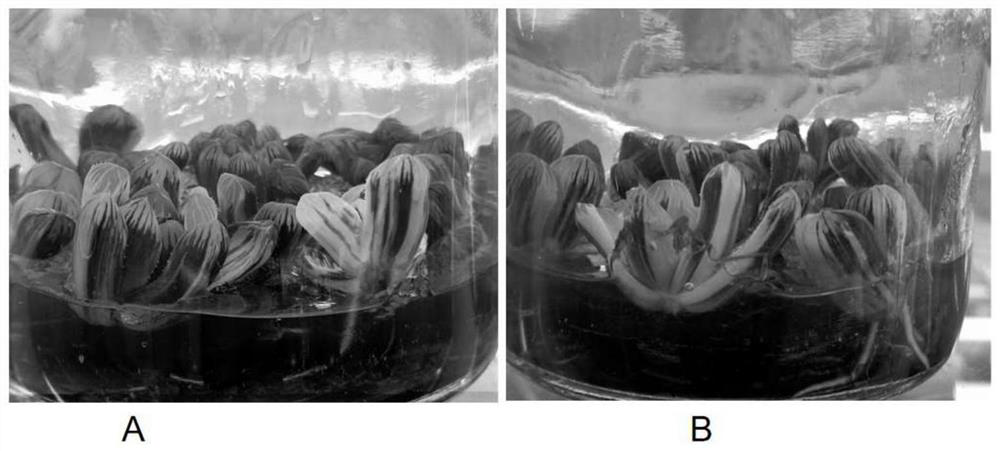Tissue culture and rapid propagation seedling raising method for large-purple-leaf variegata-provided haworthia cooperi plant
A technology of rapid propagation of seedlings, tissue culture and rapid propagation, which is applied in botany equipment and methods, planting substrates, gardening methods, etc., can solve the problems of breeding germs and pests, and achieve the effects of increased air permeability, healthy color, and soil grabbing Effect
- Summary
- Abstract
- Description
- Claims
- Application Information
AI Technical Summary
Problems solved by technology
Method used
Image
Examples
Embodiment 1
[0033] The tissue culture rapid propagation seedling raising method of embodiment 1 Daziyulujin plant
[0034] S1: Obtaining the aseptic mutant plants of Daziyulu:
[0035]Through the large-scale tissue culture and rapid propagation of ordinary Daziyulu, from a large number of sterile seedlings produced, the leaves are obviously changed from green to yellow or red, and the discoloration is uniform, pulled from the tip of the leaf to the The base of the leaf, the color penetrates the leaf surface and the back of the leaf, and the stable mutant plant - Daziyulujin, is used as the female parent to establish a sterile and rapid propagation system for Daziyulujin plants;
[0036] S2: Establishment of the rapid propagation system of Daziyulujin plants:
[0037] S21: Cutting of Daziyulujin: On the ultra-clean workbench, carefully peel off the outermost 3 to 5 leaves of Daziyulujin along the base with a sterile scalpel blade and tweezers. When peeling off the leaf base must have gro...
Embodiment 2
[0044] The tissue culture rapid propagation seedling raising method of embodiment 2 Daziyulujin plants
[0045] The difference from the above example is that the tissue culture of Daziyulujin can also use the remaining four leaves in the center of the plant after peeling off the leaves, and leave four or more leaves without peeling off, and insert the improved MS strong seedling medium together with the base of the plant After 28 days, the center of the plant with the base in the strong seedling medium grows new leaves, which become sub-adult seedlings, and the sub-adult seedlings are transferred to the improved MS rooting medium for cultivation; after 28 days, the sub-adult seedlings are It can be cultivated into tissue culture seedlings of finished Daziyulujin.
[0046] Repeat the above steps with the tissue cultured seedlings obtained in the above-mentioned embodiment 1 or embodiment 2, and perform cyclic operation to obtain cultivated seedlings through cultivation and mana...
Embodiment 3
[0047] Example 3 Effects of Different Cutting Methods on the Proliferation Mode of Daziyulujin
[0048] T1 adopts the method of embodiment 1 to cut,
[0049] T2 adopts no cutting, the whole plant is inserted, and the ramets are multiplied.
[0050] T3 cut off the leaves and put them into the culture medium,
[0051] Table 1 below shows the effect of different cutting methods on the multiplication mode of Daziyulujin.
[0052] Table 1 Comparison of the effects of different cutting methods on the multiplication mode of Daziyulujin
[0053]
[0054] As can be seen from the above table 1: under the same culture conditions, the proliferation rate of T1 (the present invention) is 5 to 7 times that of T2, reaching the highest 28 times, which greatly improves the proliferation efficiency; and the callus is only 5% , the leaves with callus can be discarded to avoid the variation caused by callus re-differentiation into seedlings, the results are shown in figure 1 (A); T2 has no ...
PUM
 Login to View More
Login to View More Abstract
Description
Claims
Application Information
 Login to View More
Login to View More - Generate Ideas
- Intellectual Property
- Life Sciences
- Materials
- Tech Scout
- Unparalleled Data Quality
- Higher Quality Content
- 60% Fewer Hallucinations
Browse by: Latest US Patents, China's latest patents, Technical Efficacy Thesaurus, Application Domain, Technology Topic, Popular Technical Reports.
© 2025 PatSnap. All rights reserved.Legal|Privacy policy|Modern Slavery Act Transparency Statement|Sitemap|About US| Contact US: help@patsnap.com



